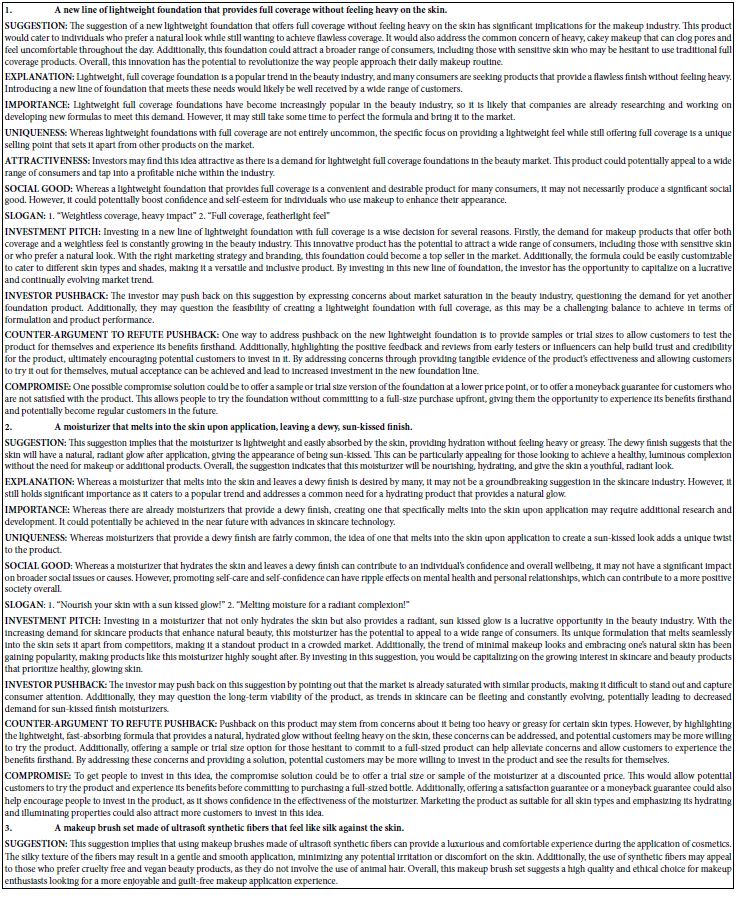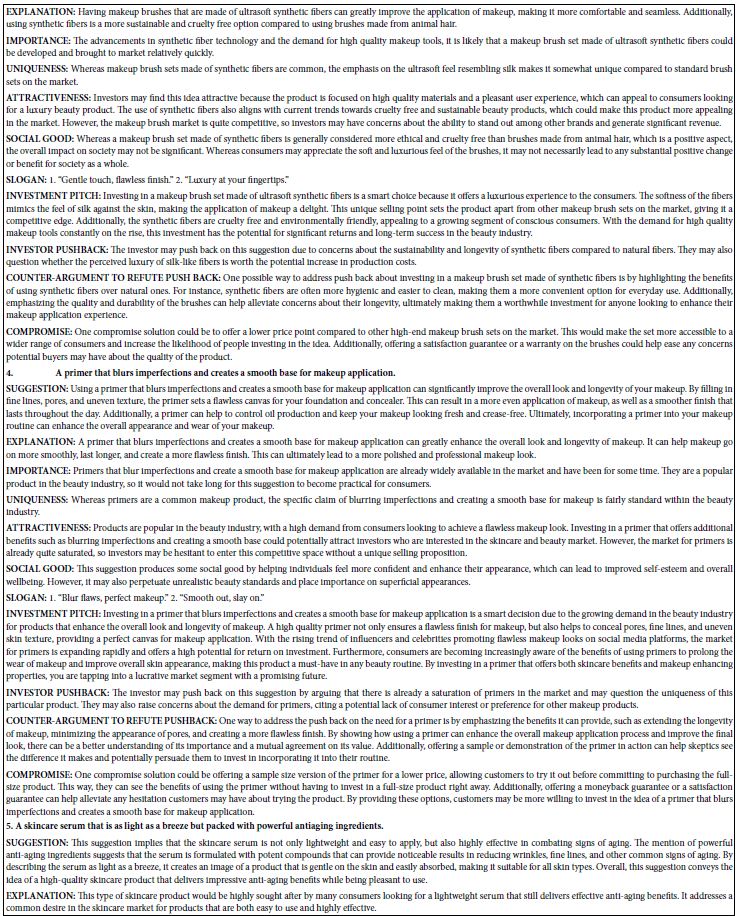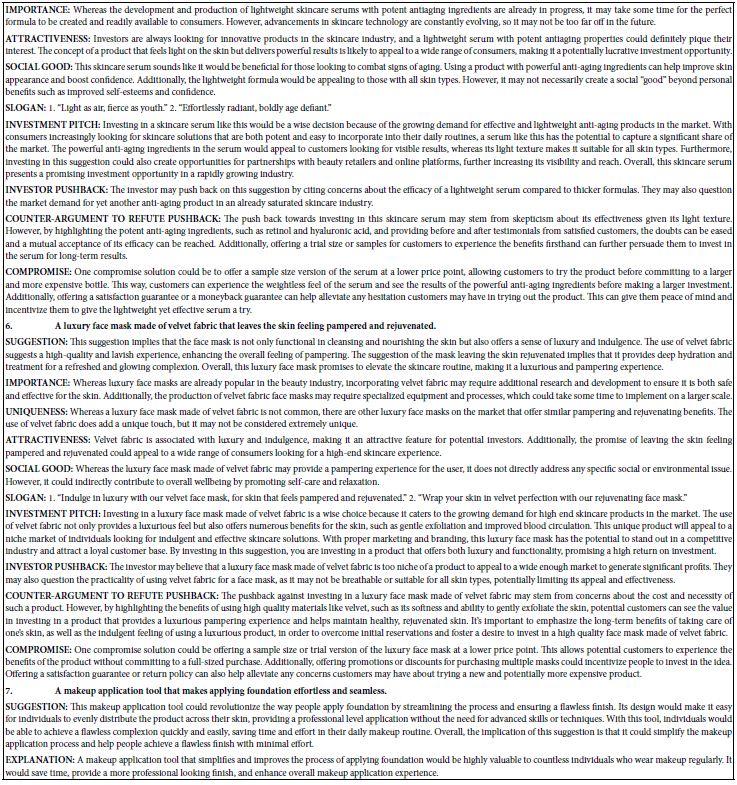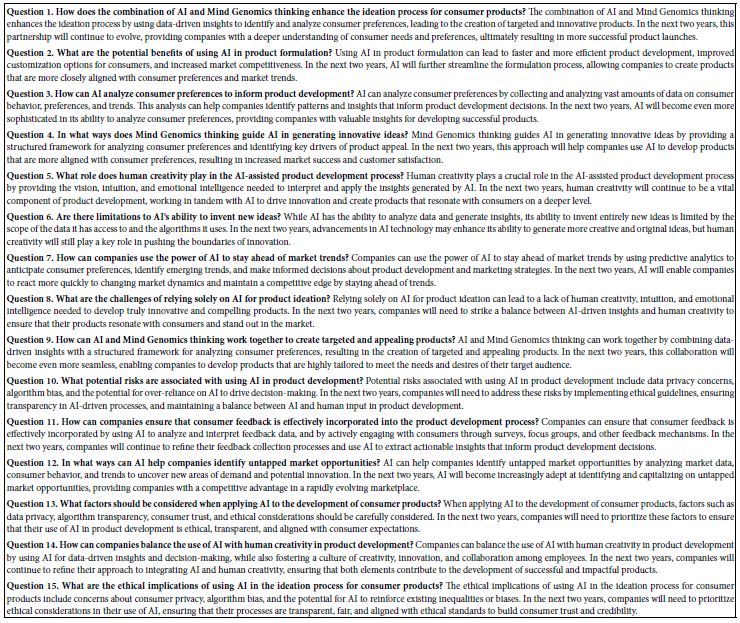Abstract
This second paper in the series of three papers on product design shows how to create a new idea for a skin lotion, using Mind Genomics coupled with AI embedded in the Mind Genomics platform, BimiLeap.com (Idea Coach feature). The user presents the AI with the request to create new ideas for a “foundation product.” The paper shows how AI provides different ideas in a single iteration and then, after the iteration is closed, continues to apply critical thinking to its own suggestions. The outcome is a detailed suggestion of 10 different lotion products that might be created, along with the nature of each product, and a business case for each product idea.
Keywords
Cosmetic development, Generative AI, Mind Genomics, Product innovation
Introduction
This second paper builds upon the material presented in the Thompson et al. paper, “Developing a New Skin Cosmetic Product: Rapid, Efficient Insights from AI Coupled with Mind Genomics Thinking at the Very Earliest Stages of Ideation with Limited or Even No Knowledge.” Once the basic product has been chosen—a lotion—the next objective was to specify the nature of this new lotion.The paper presents a novel approach to this step of specification. The approach was to create consumer-meaningful phrases that embed product features in them. Although the approach might seem difficult, viz., combining creativity and cosmetic technology, at the level of AI powered by Mind Genomics thinking, the approach is quite actually straightforward.
Table 1 presents the instruction to the AI (ChatGPT 3.5) using the Mind Genomics platform BimiLeap.com. The instructions are put into Idea Coach (Table 1 top). Within 15 seconds or so, viz., almost immediately, AI returns with the descriptions (Table 2 bottom).
Table 1: Instructions to AI about the product and the 15 different phases describing the product in “poetic” consumer language.

Table 2: Perspectives—critical thinking of the AI regarding its own suggestion of 15 phrases.

Critical Thinking Presented by AI After the Study has Closed
As in the previous study, once the project is “closed,” the AI is instructed to review its own suggestions presented to the user (Table 1). Table 2 presents the perspectives.
Table 3 continues the critical thinking, presenting the points of view of those who are in favor of these product ideas (Interested) versus those who are against these product ideas (Opposing).
Table 3: AI simulation of audiences interested in the 15 phrases (top) versus audiences opposing the 15 phrases (bottom).

The Road to Innovation—Additional Information Needs and Alternative Viewpoints
Table 4 presents information that will be useful for product design and communication. The top of Table 4 shows the AI observation about additional information needed. The bottom of Table 4 shows alternative viewpoints, viz., a “no-holds-barred” analysis of the messages in terms of where the messages veer off-target and could be improved.
Table 4: Pre-innovation. Additional information that AI says it “needs” (top), and alternative viewpoints (bottom).

Deeper Analysis of Innovations
The final analysis in this study is a set of recommended innovations, shown in Table 5. This time, AI generated 10 innovations analyzed in depth, once again doing this work after the study has been closed. Had this iteration been repeated, e.g., 20x, a task that would have taken three minutes for the user to execute by simply pressing the right key to “repeat the effort,” the Idea Coach in BimiLeap.com would have returned 20 of these full analyses, rather than the one full analysis shown in detail in this paper. That effort, requiring just an extra few minutes “upfront,” would thus generate an entire repository of information for the user.
Table 5: Ten AI-suggested innovations, together with AI’s critical analysis of each innovation on technical as well as business dimensions.



Using AI to Consider Its Own Operations
The final step in this paper is to instruct AI to reflect on the combination of AI and Mind Genomics thinking as a potential coach, collaborator, or even an occasional “lead” in the product development process. During the course of several iterations, AI returned with a variety of questions—15 of which are shown below. These questions are generated as a standard part of the output of Idea Coach in the Mind Genomics platform, BimiLeap.com. The questions are put in to spur additional thinking about the topic. Table 6 shows 15 of these questions, along with answers and then speculation about the future.
Table 6: Fifteen questions about the contribution to consumer product development by a combination of AI and Mind Genomics thinking.

Discussion and Conclusions
AI and Mind Genomics thinking are valuable tools with which to create innovative consumer products. By analyzing consumer preferences and trends, AI can generate unique and appealing ideas, allowing for targeted product development. This approach promotes creativity and experimentation, leading to groundbreaking products. Combining human insight with AI analysis allows companies to push boundaries in product development and stay ahead of competition. However, AI may not invent as well as human creativity and may struggle to think outside predefined parameters. Despite these challenges, the value of AI and Mind Genomics in product development cannot be understated, as they create products which cater to consumers’ specific needs and preferences.
Acknowledgment
The authors gratefully acknowledge the foresight of Dr. Nenad Filipovic to bring this approach of Mind Genomics to Serbia and to encourage its use among students and professionals, as well as to publish the results of papers in the scientific, technical, and business literatures.The authors wish to thank Vanessa Marie B. Arcenas and Angela Louise C. Aton for their ongoing help in preparing this and companion papers in this series.